Recent Posts
-
Real Crimes and the Coming Violence
September 6, 2025
-
Whither Modern Life?
June 27, 2025
-
What the Hell
June 18, 2025
-
As Darkness Engulfs Us
April 6, 2025
-
AI, Risk, and Work
January 17, 2025
-
“Things Are in the Saddle, and Ride Mankind”
December 29, 2024
-
Forgotten Futures in Seattle
December 12, 2024
-
Autocracy Defeats Neoliberalism
November 14, 2024
-
History… We’re Soaking in It!
October 2, 2024
-
A Numbing Spectacle
September 22, 2024
|
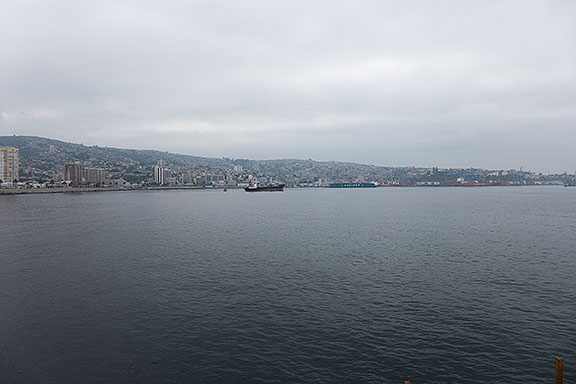 Valparaiso, Chile, view south from fishing pier in bay. Valparaiso, Chile is a spectacularly beautiful city. It seems appropriate that it is a sister-city to San Francisco as it shares the Pacific Ocean and a very hilly topography, along with the historic connection that linked Chile to San Francisco’s Gold Rush in 1849-1850. Chileans were one of the largest populations to arrive in the early days of the Gold Rush, since they were closer, though their presence was quickly overwhelmed by tens of thousands of people from France, Germany, England, the U.S., and elsewhere. There’s no memory of that Chilean connection in San Francisco these days, though as I mentioned in the previous post, a more recent wave of Chileans arrived in San Francisco during the 1970s as refugees from the Pinochet dictatorship.
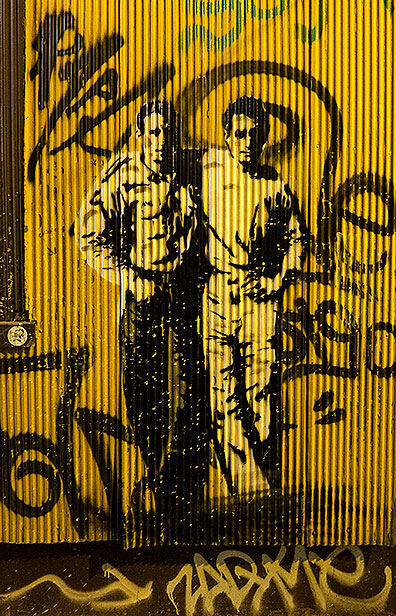 This stencil of Jack Kerouac and Neil Cassady is an iconic image used for years by City Lights Books in San Francisco… and here it was on the walls of Valparaiso, keeping alive the connection between the two cities? If we historicize that a bit more precisely, those Chileans were the first escapees from the harsh imposition of a neoliberalism determined to smash the organized working class. After the 1973 Chilean coup, new military dictatorships from Argentina to Indonesia, South Korea and the Philippines were backed by the U.S. as bulwarks of the “Free World;” at gunpoint they freed markets for international investors by breaking unions and selling off publicly owned assets. Milton Friedman’s “Chicago Boys” provided their throwback economic theories to Margaret Thatcher and Ronald Reagan and their market fundamentalism drove the reorganization of the global order that landed us in the mess we’re in now.
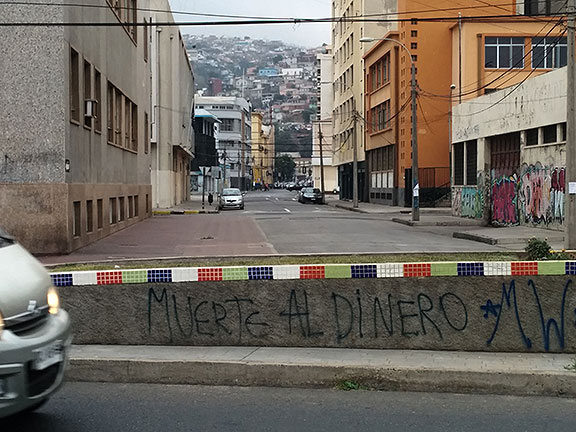 “Death to money” graffiti on coastal boulevard in Valparaiso. I went to Chile full of curiosity to see it and get my first glimpse of its culture and people. My time there was very brief so I can’t make any claims to real knowledge, but I did learn a bit about Chilean history:
- The 1879-83 War of the Pacific with Bolivia and Peru that seized territory rich in saltpeter and copper, and left Bolivia landlocked without the sea coast they had when the war started.
- A brief civil war in the 1891 between the President, backed by the Army, and the Congress, backed by the Navy, won by the latter.
- The curious coincidence between Chilean national politics and California when in 1938 both saw the election of left-leaning Popular Front governments.
Valparaiso, or Valpo as it is sometimes called, had long been a city that I imagined, and the real place did not disappoint, even if my uninformed fantasies proved to be entirely inaccurate. A bustling container port, an elegant dying old financial district, funiculars climbing from commercial lowlands to residential hillside neighborhoods, a seaside bikeway connecting Valpo to nearby wealthy enclave Vina del Mar.
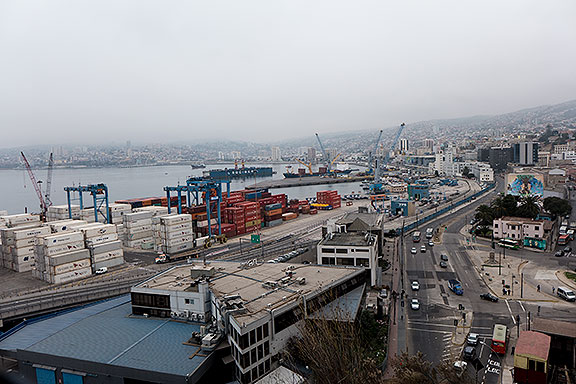 Valpo has a thriving container port. 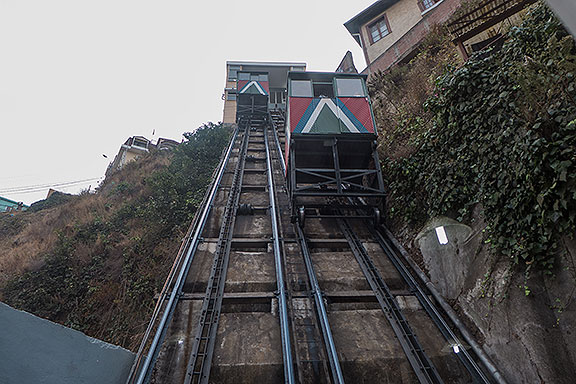 One of many ascensores, or funiculars, traversing the steep slopes. 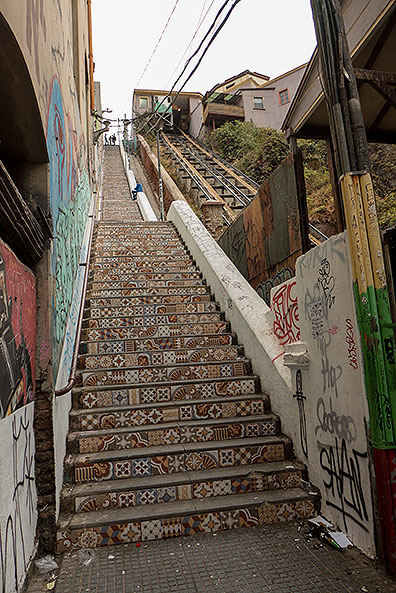 Mosaic-decorated stairs next to another funicular. 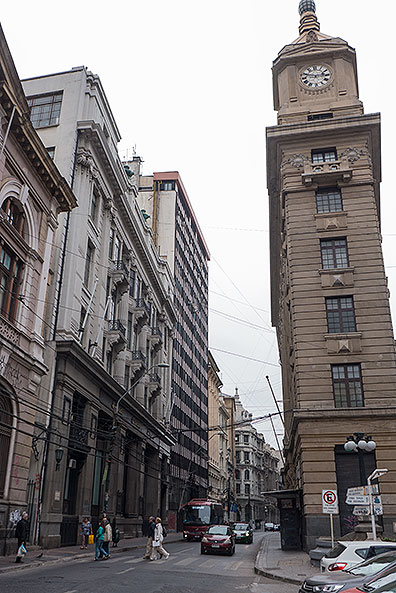 A once-bustling financial district, now rather hollowed out. Some of the hilltop neighborhoods just above the downtown area are rapidly gentrifying while adjacent areas are left mired in the poverty that neoliberal prosperity necessarily produced. Wherever I went walking around Valparaiso’s streets I found street art from graffiti to spraycan murals to sophisticated large works by very talented artists.
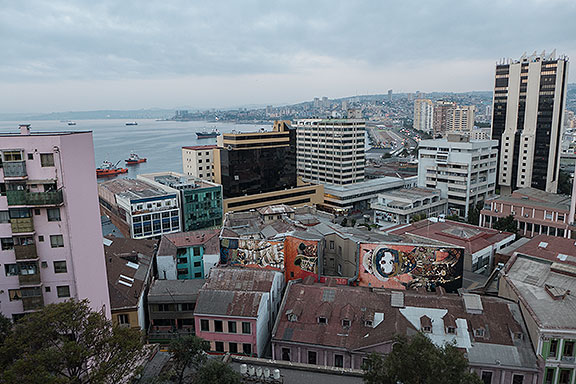 View north from hill above downtown. Gorgeous mural below! 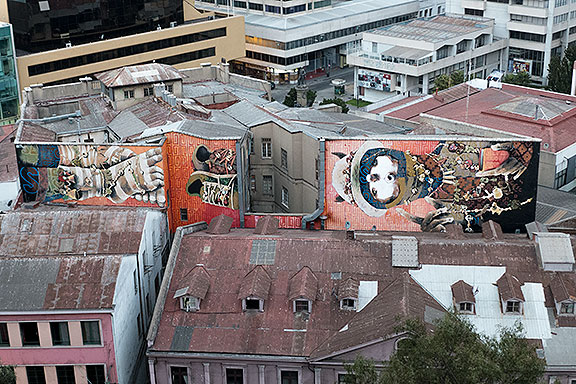 Closer view 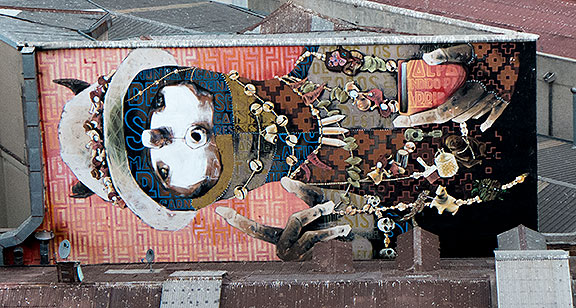 Still closer Continue reading Valparaiso: Getting a Glimpse
 I found this stencil on the wall in a bike/vegan collective warehouse in Valparaiso. I had the great pleasure of visiting Chile from March 23-April 5. My host there was Ricardo Jerez, who gave me an amazing time, great hospitality, wonderful history and stories, and made sure I was well taken care of throughout my visit. Ostensibly I went to attend the World Bike Forum, and you can read my Talk here and my ruminations on cycling as they continued after my participation here.
I had a life-long interest in Chile because of the September 11, 1973 coup, fully backed by the CIA and the Nixon-Kissinger White House. At the time I was a high school student in Oakland (at Tech) and a regular listener to KSAN-FM (“the jive 95”), at the time still in the glory period of freeform FM radio. The news department anchored by Dave McQueen and Larry Lee was an amazingly subversive source of information (supplemented regularly by the hilarious work of Wes “Scoop” Nisker) and I remember well hearing about General Pinochet’s attack on the national palace in Santiago, and the death of democratically elected socialist president Salvador Allende as it happened on their newscast. By the time I was in college at Sonoma State College (now University) in Cotati/Rohnert Park in 1975 the Chilean solidarity movement was in full bloom, based largely on the dozens of Chilean political exiles that had arrived in the Bay Area since escaping the military dictatorship that was imposed in Chile.
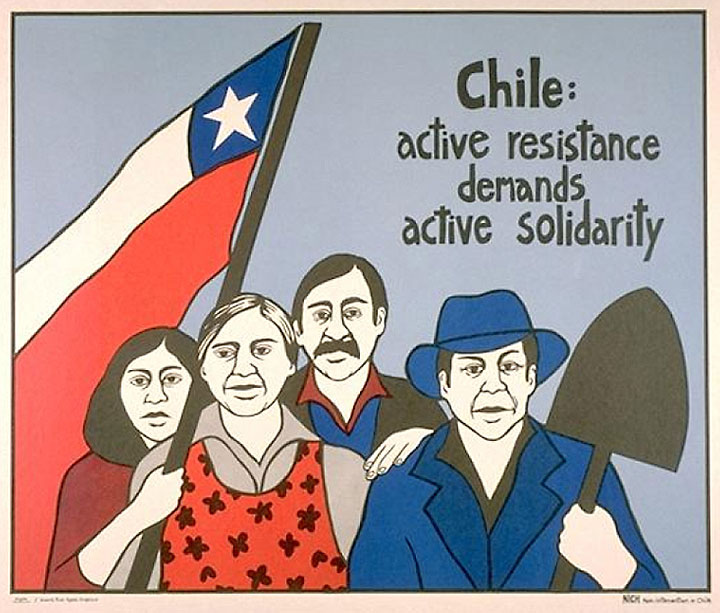
Poster by Lisa Kokin (1978), courtesy of Docs Populi
I learned a lot about Chile, the Allende period, the terror and barbarism of the Pinochet era, and participated in protesting the arrival of the “Torture Ship” Esmeralda when it sailed under the Golden Gate Bridge on a “goodwill” visit to the U.S. And I got a crash course in the “Left” when I found myself working with the Free Chile Center in San Francisco (largely full of supporters of Allende’s Popular Unity government) who were in endless conflict with the folks who founded La Peña in Berkeley (who were supporters of the MIR, the Movement of the Revolutionary Left, who had gone underground before the election of Allende and called for “arming the workers” as the antidote to the coming coup). The mid-1970s was a time when the bitter disputes between followers of the Communist Party and the Soviet Union and the growing ranks of those to their left seemed much more vital than they do in retrospect.
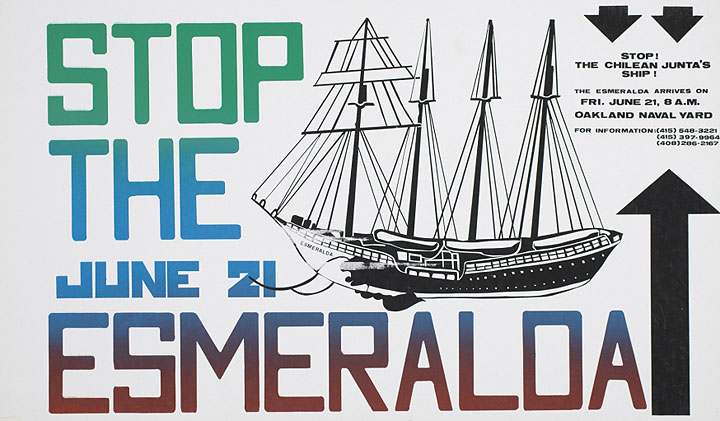
Poster courtesy of Docs Populi
 It was a bit jarring to come up on the Esmeralda docked at the Navy base that dominates the port of Valparaiso. This post will feature images from my tourism around Santiago. The next post will be focused on Valparaiso where I had the pleasure of spending a weekend and look forward to returning for a longer visit another time. In general my appetite for Chile was both satisfied and further whetted by this visit. I particularly want to visit regions to the south and north of the capital city and its nearby port (120 km) in Valparaiso.
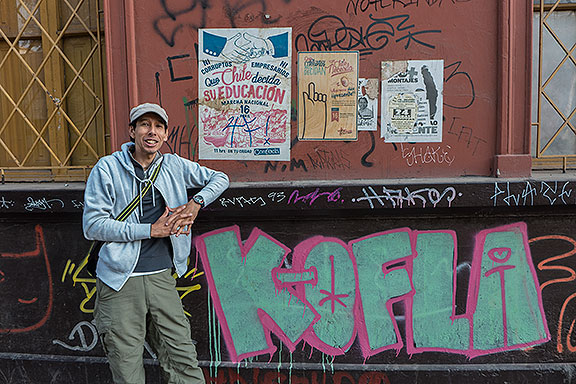 In my first hour in Santiago, Ricardo took me on a lovely walk around the place I was staying. The neighborhood walls are full of graffiti and posters. 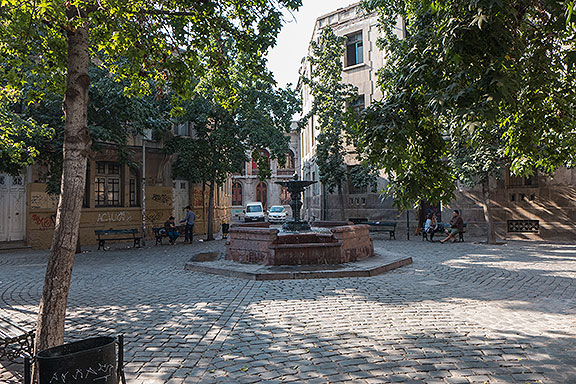 A short walk away was the “Concha y Toro” neighborhood, designed in the 19th century to replicate a cozy Parisian neighborhood. Ricardo had enjoyed several years in the adjacent building when it was abandoned, using it as a Social Center and bike workshop. Continue reading First Time in Santiago, Chile
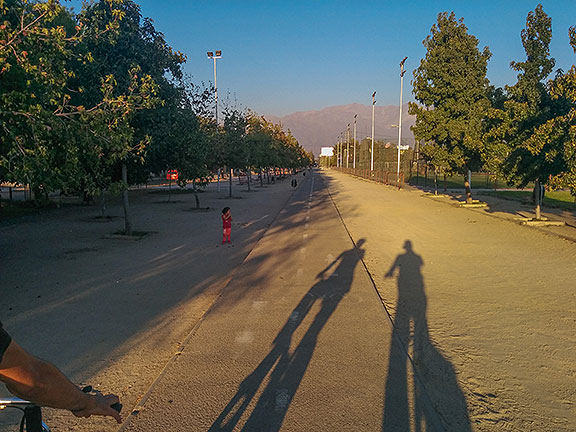 Ricardo Jerez and I bicycling on a path towards his home in Santiago, the Andes looming in the distance. It still is, isn’t it?
It is in some places, less so in others. In Latin America, from Chile and Brazil to Colombia, Panama, Peru, Ecuador, and Mexico, it is going strong. But I had an insight during the two weeks I recently spent in Chile at the Forum Mundial de Bicicleta 5 (#FMB5). Amidst presentations on all matters bicycle-related, from street designs and accessibility, to the important feminist impulse that is pushing many women to use the bicycle as a literal vehicle of personal emancipation (echoing their 19th century ancestors), to countless presentations on urban planning and livable cities, it suddenly dawned on me that we’re living through a very specific period of history. From about 1990-2020 we are transitioning from the twentieth-century commitment to automobiles to a multi-modal approach to urban transportation that foregrounds bicycling and walking, supplemented by public transit.
To be sure there are still strong political and economic forces putting up major resistance to this transition, especially given the central role of the automobile and oil industries in most industrialized economies. But literally millions of citizens across the world are “voting” on this directly by getting on bicycles and changing their daily behavior. This didn’t erupt from a policy decision on-high by some bureaucrat, but rather an urgent need by people in cities everywhere to address the ridiculous irrationality of endless traffic congestion, horrible air pollution, catastrophic collisions, neighborhoods devastated by being engineered to accommodate maximum space for high speed car use and no-speed car parking, perpetual indebtedness to pay for car costs, and so on. As social solidarity has been torn apart in societies everywhere by the horrible consequences of neoliberal capitalism and austerity, a new kind of solidarity around the embrace of the bicycle has helped many to find a remarkably joyful connection to their sister and brother cyclists.
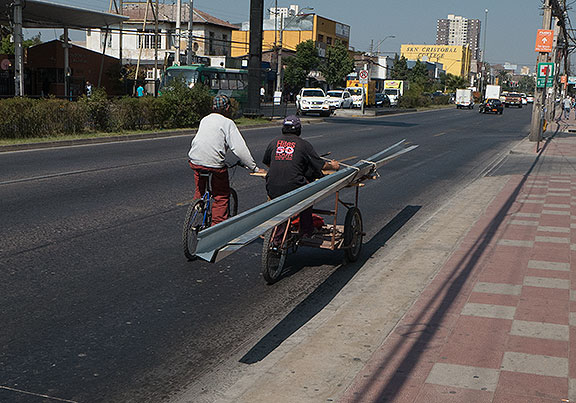 Practical bicycling… the kind that doesn’t really show up in the “bicycling culture” which tends to be a middle- and upper-middle class phenomenon in most places.  Santiago has some very decent bike lanes already, and some weirdly obsolescent ones… this one on Rosas was my favorite. 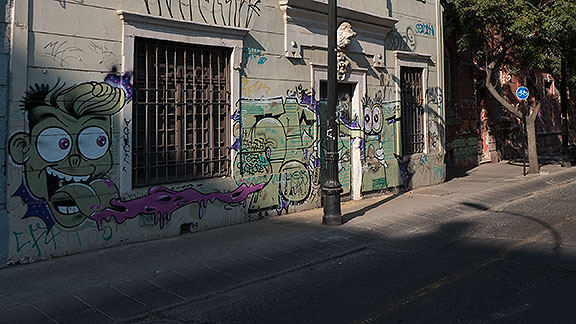 The sloping granite blocks between sidewalk and street are designated a bike-only space! Never saw anything like that before. 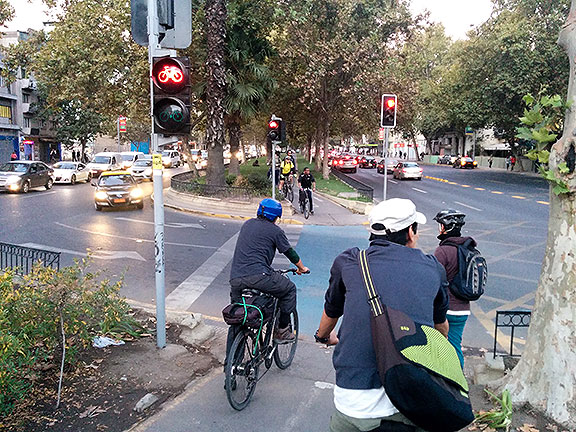 An early bike lane in Santiago runs along the center median of the Alameda, but it is full of obstacles and strange twists and turns… more of an add-on that wasn’t really designed for bicycle traffic. This “bike culture solidarity” is largely a middle- and upper-middle-class phenomenon. Poor people have been bicycling through the whole of the 20th century without making a political or cultural issue of it. Once the bike culture started to catch on during the past generation, it took root among the parts of the population who were perhaps most separated from the kind of everyday solidarity that has always been the hallmark of poorer communities. In places like Mexico, it is still not uncommon to hear people dismiss so-called “backward” small towns as “Pueblos Bicicleteros,” to denote their lack of modernity. But in a delicious turnabout, those towns can now claim to have leapfrogged the stupidity of 20th century modernism to embrace a fully modern 21st century sensibility rooted in a shared and ecologically grounded consciousness, and at ease with self-propelled mobility as a sensible first choice in lieu of oil-and-auto dependency.
Continue reading When Bicycling Was Cool
|
Hidden San Francisco 2nd EDITION!

NEW 2nd EDITION NOW AVAILABLE!
Buy one here
(Pluto Press, Spring 2025)
|
































